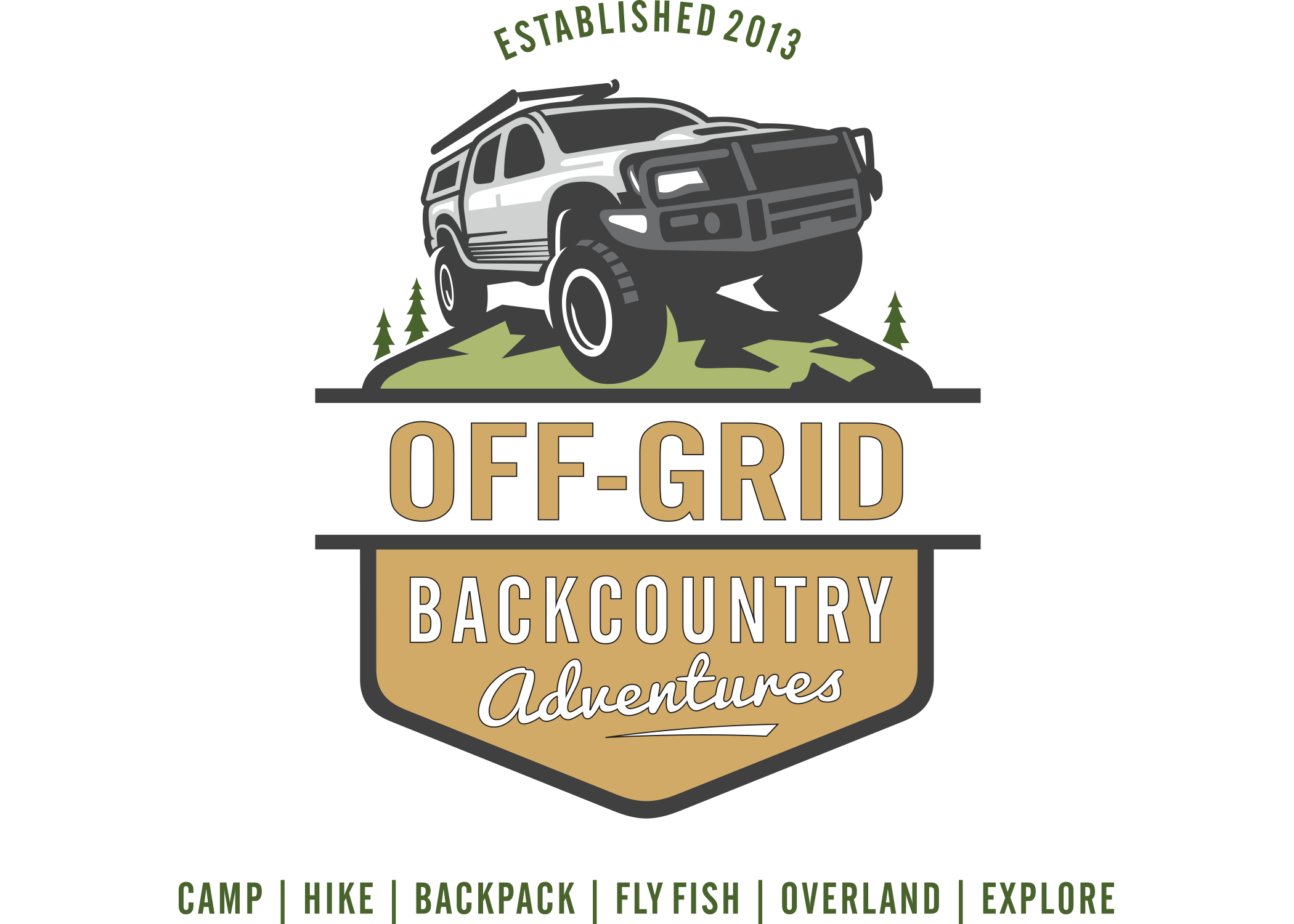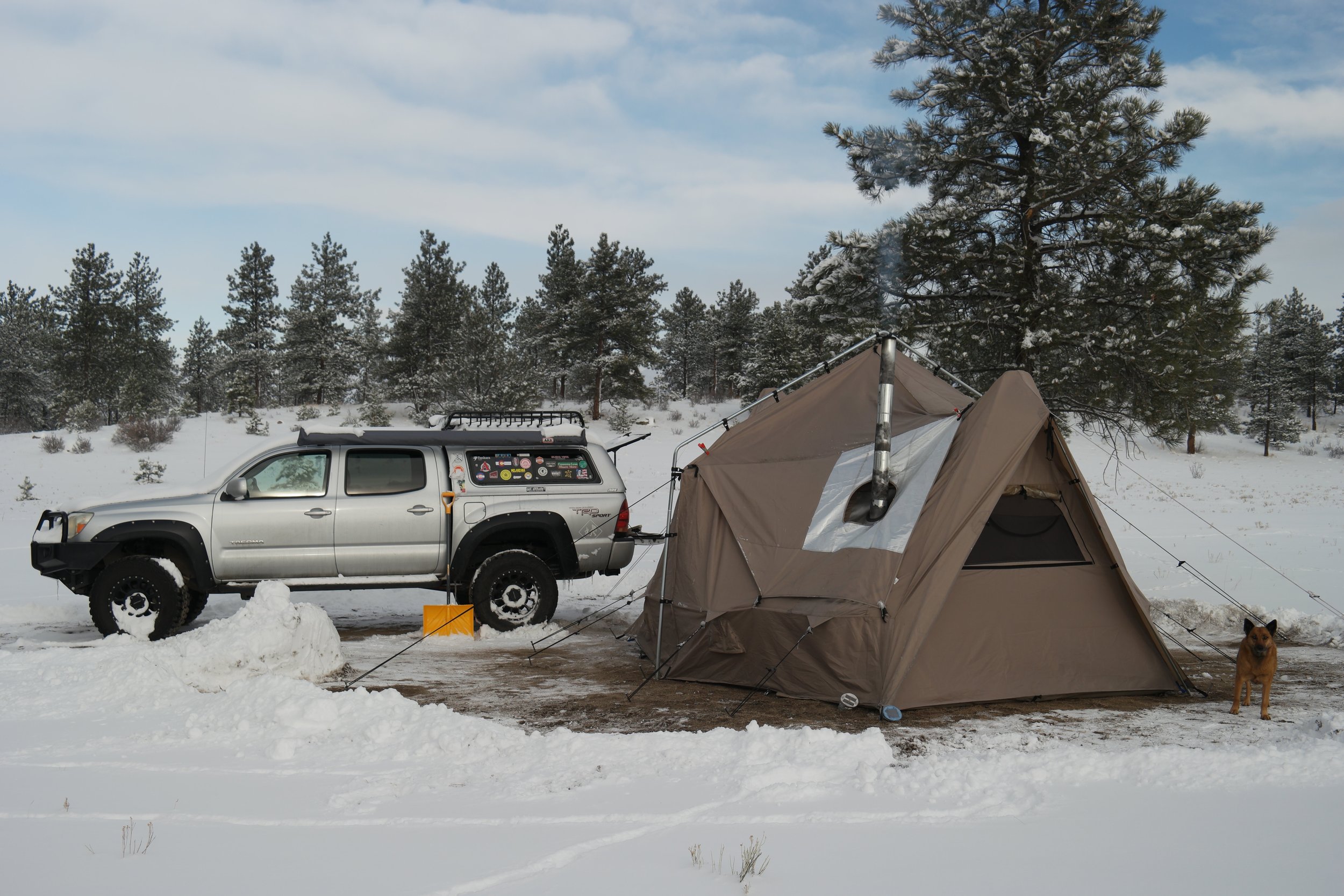My Experience in a Four-Season Tent with a Wood Stove in the Colorado Rocky Mountains
WINTER CAMPING
Before I started living outdoors full-time, I had people who told me winter camping was flat out miserable. I would think to myself “I got this, I’m good at combating the elements” but in some respects, they’re right. If you think you’re going to lounge around all day next to your wood stove sipping hot chocolate watching reindeer prance by your campsite…well, think again. You’ll work all day and then work some more once nightfall sets in. Tasks take much longer in the winter to accomplish and many times you’ll need to perform these tasks battling all sorts of adverse weather conditions. A perfect example is getting fresh water in a blizzard. How’s that possible when all the rivers and lakes are frozen over and your visibility is greatly diminished? And what do you do when your food freezes solid? How about the ever present problem of running out of wood for your stove which provides essential heat so you don't become a statistic?
However challenging this endeavor may be, the experience of winter camping is like no other. Evenings spent maintaining camp next to a cracklin’ wood stove while snow lightly falls outside, birds flying overhead and it’s so quiet you can actually hear the wind passing through their wings, morning coyotes howling off in the distance, herds of elk numbering in the hundreds passing near camp…how can you not be profoundly moved by the contrast in life experiences derived from winter camping? Yes it’s cold. Yes it’s extremely windy. Yes it’s challenging. But I say cast all doubts aside and prepare for a winter adventure. It’s the best outdoor experience you could possibly have.
In order to have success winter camping, you’ll need to understand four main areas: Gear, How to Heat Your Shelter, Weather, and Geography. From my experience, here’s what I’ve found works for full-time winter camping above 9,000ft in the Colorado Rockies.
My Tent and Sleeping Set-up:
- Cabela’s Big Horn III Outfitters Tent
- Four Dog Stove - DX Model
- Cabela’s Outfitter XL Cot
- Cabela’s Outfitter -20F/-29C Sleeping Bag
- Sea to Summit Comfort Plus Insulated Sleeping Pad - R-value of 5
Clothing & Base Layers for 15F temperatures:
- Base Layer - Patagonia Caprene thermal rating long sleeve shirt and long underwear, smart wool underwear, Melanzana wool socks.
- Mid Layer - Patagonia R-1 long sleeve shirt. I don’t typically use any mid layer pants
- Exterior Layer - Arcteryx LT Cerium Coat, Marmot Scree Pants, Fox River Wool Mittens, Wool Hat, Sorel Men's 1964 Premium T Snow Boot.
Heating your shelter:
Wood Stove - the ability to identify wood species and estimated burn time is extremely beneficial when utilizing a wood stove. Once you’ve established a nice base of coals with starter wood you can begin to add hardwoods such as pinyon pine, cedar, black walnut, white oak, hedge, etc. Certain hardwoods can provide up to 5 hour burns, great for sleeping. Another benefit of using a wood stove is for cooking. You can control the temperature of your cooking surface by increasing or decreasing the airflow into the stove, similar to the low/high settings for a gas range. I recently learned how to make cinnamon rolls in my dutch oven over the stove - dangerous for the waistline!
Passive Solar - Passive solar is your best friend while winter camping. You’ll need to set up camp in an open area to take advantage of direct sunlight, it will not work in shade. As soon as the morning sun hits your tent, solar radiation will begin warming the interior space essentially turning your shelter into a big greenhouse which will keep you warm throughout the day.
Candle Lanterns - provides minimal heat but creates a nice atmosphere. UCO makes a 3-candle candeleir with a warming tray on top which allows you to boil a cup of water in about 35 minutes using a single walled metal cup.
Propane Heater - propane is a quick, easy, and cheap way to heat your shelter. You’ll need to properly vent your tent when using propane since the build up of CO2 gas can have lethal consequences. The most common complaint when using propane is the build up of interior condensation.
Weather:
Understanding all facets of weather and how it affects the human body is extremely important. Temperature, wind, windchill, and barometric pressure - you need to know how each of these factors impact livability conditions. The most important factors for determining what gear I use while in the backcountry are wind and temperature. Plummeting temperatures can adversely impact your health so here are a few things to keep in mind:
Cold temperatures suppress the immune system, decreases blood flow to extremities, and increases blood pressure which puts strain on the heart. Limit physical exertion and pace yourself to avoid overworking your cardiovascular system.
Windchill only applies when it’s 50°F or colder outside AND when the wind is blowing greater than 3 mph. Windchill greatly decreases the amount of time frostbite and hypothermia sets in so be mindful of your present weather conditions. At -20F windchill, frostbite (ice crystals in your cells) will take place within 30 minutes.
High barometric pressure has a huge impact on headaches, especially migraines, and also affects joint pain by impacting the viscosity of fluid that lines joint sacs triggering pain responses in the nerve endings. This is the reason many people feel joint pain when a storm approaches.
Geography:
Valleys - Cold air settles in valleys because it weighs more than warm air. Camp in an area that is 200ft - 300ft higher in elevation from the valley floor and you’ll be set. I’ve noticed temperature differences as much as 15 degrees warmer at higher elevations compared to the valley floor.
Wind Barriers - wind will create many more issues during winter months and can make things miserable. Observe the general direction of wind flows through your area and set up camp close to a wind barrier. Keep in mind you don’t want this wind barrier to block out any sun that can be used as passive solar.
Rivers - don’t EVER camp next to rivers in the wintertime. It’s miserable. There is so much moisture in the air next to a river ecosystem and the windchill will brutalize you. I know from experience, one I’m not bound to repeat.
In closing, if you do choose to go winter camping I want to point out the best weapon you have in your arsenal to combat the cold is common sense. This isn’t a contest of who’s the toughest survivalist on Planet Earth. If conditions get too gnarly then pack it up and live to conquer another day. No need to push boundaries when there are real life and death consequences associated with subzero temperatures. Learn from any mistakes you may make, adjust your gear as needed, and plan your next winter camping adventure based on the knowledge you develop out in the field. Doing so will ensure a successful trip with a safe return!

